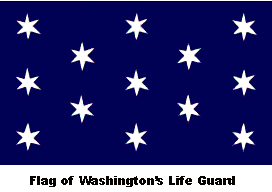
The Hickey Conspiracy
When George Washington arrived in New York after driving General Gage from Boston in the springtime of 1776, there was great concern for the general's safety. A guard unit of about 50 men was established for his protection, known officially as "His Excellency's Guard" or "The General's Guard." The popular name was "Washington's Life Guard." They first set up camp at Richmond Hill in May of 1776.

Most soldiers are no strangers to taverns and, when off duty, many took their libations at Lowrie's Tavern, The Highlander, and Corbie's Tavern located at Spring & Wooster Streets, being in close proximity to Washington's headquarters, a mansion called Richmond Hill. Sergeant Thomas Hickey, an Irish-born deserter from the British Army and a drummer, was a frequent patron of Corbie's. It is probably there that Sergeant Hickey met one evening with William Green, a fellow drummer, and James Johnson, a fifer with the Life Guards. Privates Matthew Lynch and John Barnes were also in attendance. Gilbert Forbes was the paymaster, providing 10 shillings per week to each man. The plan was to kidnap and assassinate the general. They were not alone in hatching the plan.
The plot was the creation of British General William Howe and William Tryon, the Loyalist Governor of New York, and involved as many as 40 people, including David Matthews, the mayor of New York, who contributed 100 British pounds to the project. Other prominent Loyalists, like Richard Hewlitt, also gave generously. Stories were abundant in various taverns. One stated that the dried peas in Washington's kitchen were poisoned. Although the cook pretended to go along with it, she threw them to the chickens in the garden. The birds all soon died.
Two other plans were also considered: One was to murder the general and his staff soon after the British made the inevitable attack on the city. The other was to forcibly convey the general through a rear door of his headquarters and out to a waiting boat on the East River. He would then be carried to a British ship to be tried for treason.
The entire conspiracy came to naught when Sergeant Hickey was arrested for attempting to pass counterfeit bank notes. He was locked up in City Hall jail, where he made the acquaintance of another counterfeiter named Isaac Ketchum. In a careless moment, Hickey attempted to recruit his cellmate. Ketchum, seeing an opportunity for freedom, told authorities what he had heard. A major investigation ensued, resulting in the rounding up of many Loyalists who were involved in the conspiracy. Tryon was safe on the "Dutchess of Gordon," a British ship in the harbor. Hewlitt escaped, as did a few others. All but one spent time in prison, but Mayor Matthews eventually escaped to England.
Sergeant Hickey appeared before a court martial on June 24, 1776 and was found guilty of mutiny - treason. He was sentenced to death by hanging. On June 27, Washington and his staff agreed with the sentence. On the morning of the execution, Washington wrote to John Hancock, president of the Continental Congress. In his communication, he said, "I am hopeful this example will produce many salutary consequences, and deter others from entering into like traitorous (sic) practices."
On June 28, soldiers from the Spencer, Scott, and Sterling brigades marched to the execution site, Colonel Rutger's field, a meadow near Bowery Lane. Hickey, the first American soldier ever to be executed in the Continental army, was escorted by an armed guard. As they approached, the fifes and drums played the customary Dead March. All physical punishments in the army, floggings and drumming out ceremonies, were conducted by drummers or regimental drum majors. Consequently, the executioner on that day was an unidentified drummer who used the new "short drop" method that was considered to be quick and merciful. It was witnessed by more than 20,000 military and civilian spectators. For such corporal punishment as flogging, walking a gauntlet, or when a soldier was drummed out, the Rogues March was usually played.
The very next day, countless British mastheads were visible on the horizon off Long Island, growing in number by the hour. The war had taken a terrible new direction. General Washington was safe for now.
Dead March below from Willing's Compleat Tutor for the Fife (1804), page 11.

Rogues March from Songs for Fifers to Play

© EW Boyle, 2002